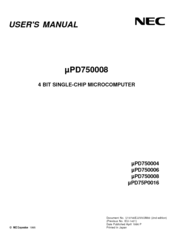NEC PD750004 Manuals
Manuals and User Guides for NEC PD750004. We have 1 NEC PD750004 manual available for free PDF download: User Manual
NEC PD750004 User Manual (342 pages)
4 BIT SINGLE-CHIP MICROCOMPUTER
Brand: NEC
|
Category: Computer Hardware
|
Size: 1.22 MB
Table of Contents
Advertisement
Advertisement
